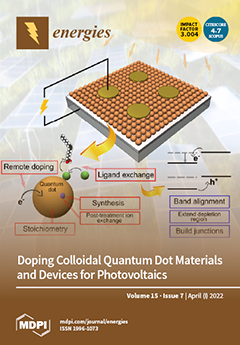This work includes calculations of the cumulative CO
2 emissions of two comparable cars—the VW Golf VII—one with a combustion engine and the other with an electric motor. Calculation of CO
2 emissions was performed, taking into account the stages of production, utilization and use of the above-mentioned vehicles. For the use phase, it was assumed that the total mileage of the car will be 150,000 km over 10 years. For the electric vehicle, calculations were made assuming five different sources of electricity (from coal only, from natural gas only, from PV and wind turbines, an average mix of European power sources and an average mix of Polish power sources; W1–W5 designations, respectively). For individual sources of electricity, cumulative CO
2 emissions were taken into account, that is, resulting both from the production of electricity and the use of the resources (for example, technical service per 1 kWh of electricity produced). The obtained results of the analysis show that for the adopted assumptions regarding operation, for variants W2–W5, the use of an electric car results in lower cumulative CO
2 emission than a the use of a combustion car. For a combustion car, the value was 37,000 kg-CO
2, and for an electric car, depending on the variant, the value was 43, 31, 16, 23 and 34 thousand kg-CO
2 for variants W1 to W5, respectively. Based on the emissions results obtained for individual stages of the use of selected vehicles, a comparative analysis of cumulative CO
2 emissions was performed. The purpose of this analysis was to determine whether the replacement of an existing combustion car (that has already been manufactured; therefore, this part of the analysis does not include CO
2 emissions in the production stage) with a new electric car, which has to be manufactured, therefore associated with additional CO
2 emissions, would reduce cumulative CO
2 emissions. Considering three adopted average annual car mileages (3000, 7500 and 15,000 km) and the previously described power options (W1–W5), we sought an answer as to whether the use of a new electric car would be burdened with lower cumulative CO
2 emissions. In this case we assumed an analysis time of 15 years. For the worst variant from the point of view of CO
2 emissions (W1, electricity from coal power sources only), further use of a combustion car is associated with lower cumulative CO
2 emissions than the purchase of a new electric car over the entire analyzed period of 15 years. In turn, for the most advantageous variant (W3, electricity from PV or wind power sources) with an annual mileage of 3000 km, the purchase of a new electric car results in higher cumulative CO
2 emissions throughout the analyzed period, whereas for an annual milage of 7500 or 15,000 km, replacing the car with an electric car “pays back” in terms of cumulative CO
2 emissions after 8.5 or 4 years, respectively.
Full article





